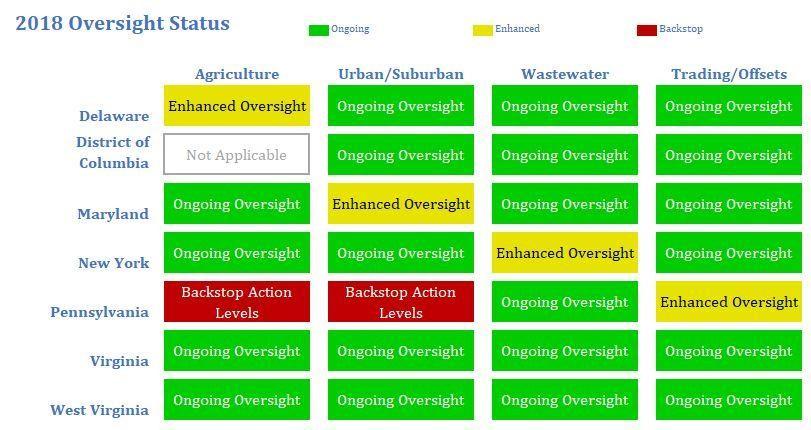EPA has released its midpoint assessment of efforts by Delaware, Maryland, New York, Pennsylvania, Virginia, West Virginia, the District of Columbia and the federal agencies to reduce nitrogen, phosphorus and sediment pollution to the Chesapeake Bay. As part of the assessment of midpoint progress, EPA provided its evaluations of the Bay jurisdictions' and federal agencies' progress towards meeting their 2016-2017 milestones and 2018-2019 commitments.
The Chesapeake Bay Total Maximum Daily Load calls for having controls in place to achieve 60 percent of the needed reductions by 2017 as compared to 2009. The assessment found that the jurisdictions have made considerable progress in reducing pollution that is reflected in measurable ways, including record acreage Exitof underwater grasses and the highest estimates Exitof water quality standards attained in more than 30 years. While the 60 percent goals for reducing phosphorus and sediment as measured under the current suite of modeling tools were exceeded, the goal for reducing nitrogen was not met. The jurisdictions will have an opportunity to optimize their pollution control strategies moving forward.
EPA evaluates the milestone commitments that each jurisdiction makes every two years. In addition, EPA conducts, at a minimum, biennial reviews of the progress that each jurisdiction has made towards achieving the TMDL targets and milestone commitments. EPA identifies its level of oversight for each sector in each jurisdiction. The 2018 oversight status is shown here:

Ongoing oversight: EPA, while having no significant concerns with a jurisdiction’s strategy to implement the TMDL goals, will continue to monitor progress.
Enhanced Oversight: EPA, having identified specific concerns with a jurisdiction’s strategy to implement the TMDL goals, may take additional federal actions, as necessary, to ensure that the jurisdiction stays on-track.
Backstop Actions Level: EPA, having identified substantial concerns with a jurisdictions' strategy to implement the TMDL goals, has taken necessary Federal Actions to help the jurisdiction get back on-track.
View the detailed evaluations for the Bay jurisdictions and federal agencies, as well as a fact sheet which provides a summary of the progress from 2009 through 2017 below.
You may need a PDF reader to view some of the files on this page. See EPA’s About PDF page to learn more.
-
Midpoint Assessment of the Chesapeake Bay Total Maximum Daily Load (PDF)(4 pp, 4 MB)
Fact sheet of pollutant reduction milestone achievements, progress and future targets by Chesapeake Bay jurisdictions as of 2018.
- EPA Evaluation of Delaware's 2016-2017 and 2018-2019 Milestones (PDF)(5 pp, 105 K)
- EPA Evaluation of the District of Columbia's 2016-2017 and 2018-2019 Milestones (PDF)(6 pp, 134 K)
- EPA Evaluation of Maryland's 2016-2017 and 2018-2019 Milestones (PDF)(6 pp, 123 K)
- EPA Evaluation of New York's 2016-2017 Progress and 2018-2019 Milestones (PDF)(5 pp, 105 K)
- EPA Evaluation of Pennsylvania's 2016-2017 and 2018-2019 Milestones (PDF)(6 pp, 93 K)
- EPA Evaluation of Virginia's 2016-2017 and 2018-2019 Milestones (PDF)(6 pp, 80 K)
- EPA Evaluation of West Virginia's 2016-2017 and 2018-2019 Milestones (PDF)(5 pp, 50 K)
- EPA Evaluation of Federal Agencies 2016-2017 Chesapeake Bay Total Maximum Daily Load Progress and 2018-2019 Milestones (PDF)(10 pp, 146 K)
